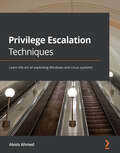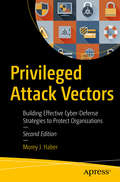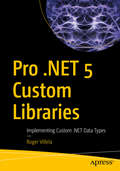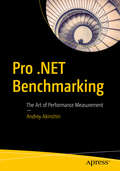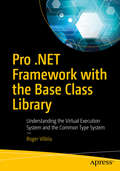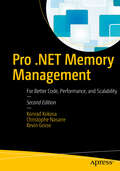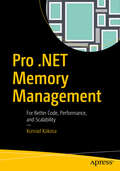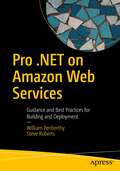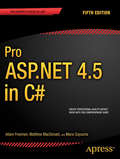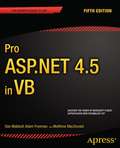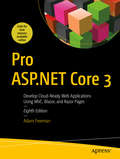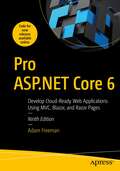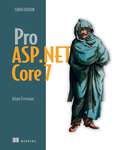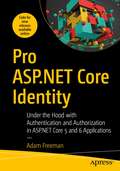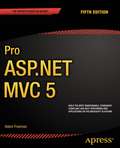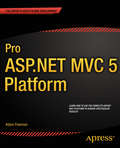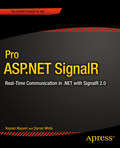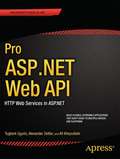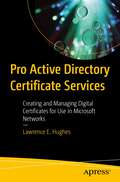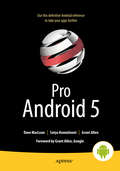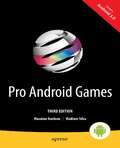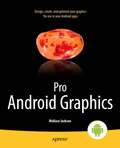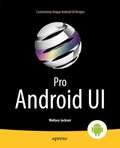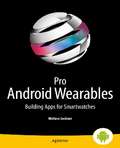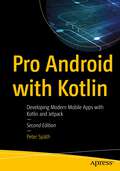- Table View
- List View
Privilege Escalation Techniques: Learn the art of exploiting Windows and Linux systems
by Alexis AhmedEnumerate and exploit Linux or Windows systems and escalate your privileges to the highest levelKey FeaturesDiscover a range of techniques to escalate privileges on Windows and Linux systemsUnderstand the key differences between Windows and Linux privilege escalationExplore unique exploitation challenges in each chapter provided in the form of pre-built VMsBook DescriptionPrivilege escalation is a crucial step in the exploitation life cycle of a penetration tester. It helps penetration testers to set up persistence and facilitates lateral movement. This book is one of a kind, covering a range of privilege escalation techniques and tools for both Windows and Linux systems. The book uses virtual environments that you can download to test and run tools and techniques. Each chapter will feature an exploitation challenge in the form of pre-built virtual machines (VMs). As you progress, you will learn how to enumerate and exploit a target Linux or Windows system. This privilege escalation book then demonstrates how you can escalate your privileges to the highest level. By the end of this book, you will have gained the skills you need to be able to perform local kernel exploits, escalate privileges through vulnerabilities in services, maintain persistence, and enumerate information from the target such as passwords and password hashes.What you will learnUnderstand the privilege escalation process and set up a pentesting labGain an initial foothold on the systemPerform local enumeration on target systemsExploit kernel vulnerabilities on Windows and Linux systemsPerform privilege escalation through password looting and finding stored credentialsGet to grips with performing impersonation attacksExploit Windows services such as the secondary logon handle service to escalate Windows privilegesEscalate Linux privileges by exploiting scheduled tasks and SUID binariesWho this book is forThis Windows and Linux privilege escalation book is for intermediate-level cybersecurity students and pentesters who are interested in learning how to perform various privilege escalation techniques on Windows and Linux systems, which includes exploiting bugs, design flaws, and more. An intermediate-level understanding of Windows and Linux systems along with fundamental cybersecurity knowledge is expected.
Privileged Attack Vectors: Building Effective Cyber-Defense Strategies to Protect Organizations
by Morey J. HaberSee how privileges, insecure passwords, administrative rights, and remote access can be combined as an attack vector to breach any organization. Cyber attacks continue to increase in volume and sophistication. It is not a matter of if, but when, your organization will be breached. Threat actors target the path of least resistance: users and their privileges. In decades past, an entire enterprise might be sufficiently managed through just a handful of credentials. Today’s environmental complexity has seen an explosion of privileged credentials for many different account types such as domain and local administrators, operating systems (Windows, Unix, Linux, macOS, etc.), directory services, databases, applications, cloud instances, networking hardware, Internet of Things (IoT), social media, and so many more. When unmanaged, these privileged credentials pose a significant threat from external hackers and insider threats. We are experiencing an expanding universe of privileged accounts almost everywhere.There is no one solution or strategy to provide the protection you need against all vectors and stages of an attack. And while some new and innovative products will help protect against or detect against a privilege attack, they are not guaranteed to stop 100% of malicious activity. The volume and frequency of privilege-based attacks continues to increase and test the limits of existing security controls and solution implementations. Privileged Attack Vectors details the risks associated with poor privilege management, the techniques that threat actors leverage, and the defensive measures that organizations should adopt to protect against an incident, protect against lateral movement, and improve the ability to detect malicious activity due to the inappropriate usage of privileged credentials. This revised and expanded second edition covers new attack vectors, has updated definitions for privileged access management (PAM), new strategies for defense, tested empirical steps for a successful implementation, and includes new disciplines for least privilege endpoint management and privileged remote access. What You Will LearnKnow how identities, accounts, credentials, passwords, and exploits can be leveraged to escalate privileges during an attack Implement defensive and monitoring strategies to mitigate privilege threats and risk Understand a 10-step universal privilege management implementation plan to guide you through a successful privilege access management journeyDevelop a comprehensive model for documenting risk, compliance, and reporting based on privilege session activity Who This Book Is For Security management professionals, new security professionals, and auditors looking to understand and solve privilege access management problems
Pro .NET 5 Custom Libraries: Implementing Custom .NET Data Types
by Roger VillelaLeverage .NET 5, Microsoft’s bold new cross-platform implementation, for developing your very own cross-platform custom data types and libraries for Windows, Linux, and macOS. The book starts with the purpose and benefits of a custom cross-platform model of .NET data types and its architectural implementation in detail. Next, you will learn fundamental operations such as the equality and inequality operations in .NET 5, demonstrated with sample projects in C#. Implementation of comparison and sorting operations is discussed next followed by a discussion on cloning operations. Here you will learn details of overriding the clone virtual method and its implementation. Moving forward, you will understand custom formatting with specialized .NET data types in various functions and how to implement it. You will then go through .NET reference types along with developing a custom library for working with the software project. Finally, you will explore .NET 5 assemblies and modules followed by their APIs. After reading Pro .NET 5 Custom Libraries, you will be able to work on fundamental operations for productivity and quality in your designs of .NET 5 custom data types. What You Will Learn Work with .NET 5 assemblies Work with .NET 5 modules Understand the logical and physical organization of .NET 5 modules Implement custom .NET reference types from scratchImplement a custom .NET value type from scratchWho This Book Is ForSoftware developers working on .NET and .NET Core platform.
Pro .NET Benchmarking: The Art of Performance Measurement
by Andrey AkinshinUse this in-depth guide to correctly design benchmarks, measure key performance metrics of .NET applications, and analyze results. This book presents dozens of case studies to help you understand complicated benchmarking topics. You will avoid common pitfalls, control the accuracy of your measurements, and improve performance of your software.Author Andrey Akinshin has maintained BenchmarkDotNet (the most popular .NET library for benchmarking) for five years and covers common mistakes that developers usually make in their benchmarks. This book includes not only .NET-specific content but also essential knowledge about performance measurements which can be applied to any language or platform (common benchmarking methodology, statistics, and low-level features of modern hardware).What You'll LearnBe aware of the best practices for writing benchmarks and performance testsAvoid the common benchmarking pitfallsKnow the hardware and software factors that affect application performanceAnalyze performance measurementsWho This Book Is For.NET developers concerned with the performance of their applications
Pro .NET Framework with the Base Class Library: Understanding the Virtual Execution System and the Common Type System
by Roger VillelaLearn about the fundamentals and inner workings of the Common Type System (CTS) and the Virtual Execution System (VES) of the Common Language Runtime (CLR) and how they relate to the Base Class Library (BCL) from the perspective of the execution environment.The author first gives an introduction to the .NET Framework and describes the architectural and engineering resources required when implementing the .NET Framework on any platform. Next, you will learn about the BCL and understand how to work with system structures including the fundamental built-in types system.array and system.string. You will then learn about the VES along with its methods and functionality. Further, you will go through the Common Intermediate Language (CIL), Assembly Manifest, and versioning. You will also learn how to design and implement libraries in detail by creating a .NET class library. After reading this book, you will understand .NET Framework features, as well as details about the core functionalities of the VES and elements of the CTS.What You Will LearnDiscover details of the Common Type System (CTS)Work with the Virtual Execution System (VES)See the importance of correct use of fundamental built-in managed typesCarry out good programming practice in a managed environment Implement a .NET class libraryWho Is This Book ForDevelopers who are working with the .NET Framework on Windows.
Pro .NET Memory Management: For Better Code, Performance, and Scalability
by Christophe Nasarre Konrad Kokosa Kevin GosseUnderstand .NET memory management internal workings, pitfalls, and techniques in order to effectively avoid a wide range of performance and scalability problems in your software. Despite automatic memory management in .NET, there are many advantages to be found in understanding how .NET memory works and how you can best write software that interacts with it efficiently and effectively. This book is your comprehensive guide to writing better software by understanding and working with memory management in .NET, from Framework up to .NET 8. Thoroughly vetted by the .NET Team at Microsoft, this book contains valuable troubleshooting scenarios designed to help diagnose challenging memory problems. You will also benefit from a multitude of .NET memory management “rules” to live by that introduce methods for writing memory-aware code and the means for avoiding common, destructive pitfalls. What You'll Learn Understand the theoretical underpinnings of automatic memory management Take a deep dive into every aspect of .NET memory management, including detailed coverage of garbage collection (GC) implementation, that would otherwise take years of experience to acquire Get practical advice on how this knowledge can be applied in real-world software development Use practical knowledge of tools related to .NET memory management to diagnose various memory-related issues Explore various aspects of advanced memory management, including use of Span and Memory types Who This Book Is For .NET developers, solution architects, and performance engineers
Pro .NET Memory Management: For Better Code, Performance, and Scalability
by Konrad KokosaUnderstand .NET memory management internal workings, pitfalls, and techniques in order to effectively avoid a wide range of performance and scalability problems in your software. Despite automatic memory management in .NET, there are many advantages to be found in understanding how .NET memory works and how you can best write software that interacts with it efficiently and effectively. Pro .NET Memory Management is your comprehensive guide to writing better software by understanding and working with memory management in .NET.Thoroughly vetted by the .NET Team at Microsoft, this book contains 25 valuable troubleshooting scenarios designed to help diagnose challenging memory problems. Readers will also benefit from a multitude of .NET memory management “rules” to live by that introduce methods for writing memory-aware code and the means for avoiding common, destructive pitfalls.What You'll LearnUnderstand the theoretical underpinnings of automatic memory managementTake a deep dive into every aspect of .NET memory management, including detailed coverage of garbage collection (GC) implementation, that would otherwise take years of experience to acquireGet practical advice on how this knowledge can be applied in real-world software developmentUse practical knowledge of tools related to .NET memory management to diagnose various memory-related issuesExplore various aspects of advanced memory management, including use of Span and Memory typesWho This Book Is For.NET developers, solution architects, and performance engineers
Pro .NET on Amazon Web Services: Guidance and Best Practices for Building and Deployment
by William Penberthy Steve RobertsThis book provides in-depth guidance and best practices for .NET developers new to working with Amazon Web Services. AWS is the world’s most comprehensive and broadly adopted cloud platform, and this book will help you choose from, and use, its extensive collection of cloud services when developing and hosting your .NET applications in the cloud. Pro .NET on Amazon Web Services focuses on the building and deployment of .NET applications on AWS. It demonstrates best practices and provides prescriptive guidance around moving existing .NET Framework, .NET Core, and .NET 5+ applications to AWS. It also offers directions on building new, distributed, and reliable cloud-native applications. You will learn how to take advantage of the various tools available from AWS to build and deploy .NET-based applications. You will also be shown how to take advantage of different AWS services, including various execution platforms and databases that can help your .NET applications to achieve the reliability and scalability that AWS is known for. What You Will Learn Develop and deploy Microsoft .NET applications on the Amazon Web Services platformTake advantage of the various free tools AWS offers for developing and deploying cloud applicationsChoose the correct compute service on which to host your applicationChoose the right database from the many options that AWS offersMake AWS service calls from within .NET applicationsSecure .NET applications using best practices around AWS Identity and Access Management (IAM)Migrate existing .NET applications to the AWS platform and take advantage of the services offeredBuild modern .NET applications using advanced AWS services Who This Book Is For .NET developers seeking to take advantage of the breadth and depth of functionality in the AWS cloud, as well as developers who, whether new to cloud applications or experienced in the cloud, face challenges in understanding and applying the breadth and depth of services available from AWS when choosing to develop and host their applications. It will also be useful for those interested in extending their application’s functionality through calling AWS services from within their applications, and who want to apply best practices for building and securing modern distributed .NET applications in the Amazon Web Services cloud.
Pro ASP.NET 4.5 in C#
by Adam FreemanASP. NET 4. 5 remains Microsoft's preferred technology for creating dynamic websites, providing developers with unrivaled power and flexibility. Pro ASP. NET 4. 5 in C# is the most complete reference to ASP. NET that you will find. This comprehensively revised fifth edition will teach you everything you need to know in order to create well-designed ASP. NET websites. Beginning with core concepts the book progresses steadily through key professional skills. You'll be shown how to query databases in detail, consider the myriad applications of XML, and step through all the considerations you need to be aware of when securing your site from intruders. Finally, you'll consider advanced topics such as using client-side validation, jQuery and Ajax. By the time you have read this book you will have learned all the skills you need to use ASP. NET 4. 5 with confidence.
Pro ASP.NET 4.5 in VB
by Matthew Macdonald Adam Freeman Dan MabbuttASP. NET 4. 5 remains Microsoft''s preferred technology for creating dynamic websites, providing developers with unrivaled power and flexibility. Pro ASP. NET 4. 5 in VB is the most complete reference to ASP. NET that you will find. This comprehensively revised fifth edition will teach you everything you need to know in order to create well-designed ASP. NET websites. Beginning with core concepts the book progresses steadily through key professional skills. You''ll be shown how to query databases in detail, consider the myriad applications of XML, and step through all the considerations you need to be aware of when securing your site from intruders. Finally, you''ll consider advanced topics such as using client-side validation, jQuery and Ajax. By the time you have read this book you will have learned all the skills you need to use ASP. NET 4. 5 with confidence. What you''ll learn Understand why ASP. NET 4. 5 is so special, what its fundamental principles are, the basics of Visual Studio, how ASP. NET controls are created and how they fit into ASP. NET pages, ultimately creating full applications. Become familiar with ASP. NET MVC 4, one of the biggest additions to ASP. NET 4, and understand how to use it and integrate it within your existing ASP. NET applications. Discover the intricacies of ADO. NET and the Entity Framework and how to perform data binding to many sources, from databases to file streams and XML. Learn the various forms of security available and how to best apply them. Once considered the Achilles'' heel of all Windows web applications, security has vastly improved and is now a cornerstone of ASP. NET. Examine in detail advanced user interface techniques, including user controls, customer server controls, client-side JavaScript, GDI+, and Silverlight. Understand how to work with web services, an important skill in an increasingly connected world. Use ASP. NET AJAX, HTML and JavaScript, with an emphasis on contemporary web development techniques. Who this book is for This book is aimed at developers with a basic understanding on the . NET Framework who want to learn how to use it in a professional environment. Migrating readers without this foundation would be well served by reading Beginning ASP. NET 4. 5 in VB, also by Apress, before tackling this book. Table of Contents Part 1: Your First ASP. NET Application Part 1: Putting ASP. NET in Context Part 1: Essential Language Features Part 1: Using jQuery Part 1: Essential Development Tools Part 1: SportsStore: A Real Application Part 1: SportsStore: Navigation & Cart Part 1: SportsStore: Completing the Cart Part 1: SportsStore: Administration Part 1: SportsStore: Deployment Part 1: Testable Web Apps Part 2: Working with Web Forms Part 2: Lifecycle Events & Context Part 2: Modules Part 2: Handlers Part 2: Page & Control Lifecycle Events Part 2: Managing Request Execution Part 2: Managing State Data Part 2: Caching Data Part 2: Caching Output Part 2: Handling Errors Part 2: Managing Paths Part 2: URL Routing Part 2: Advanced URL Routing Part 2: Authentication Part 2: Membership Part 2: ASP. NET Configuration Part 2: Asynchronous Request Handling Part 3: Working with Controls Part 3: Forms and Request Validation Part 3: Creating Custom Controls Part 3: Stateful Controls Part 3: Server-Side HTML Elements Part 3: Model Binding Part 3: Data Binding Part 3: Basic Data Controls Part 3: Complex Data Controls Part 3: Other Controls Part 4: Managing Scripts & Styles Part 4: Ajax & Web Services Part 4: Client-Side Validation
Pro ASP.NET Core 3: Develop Cloud-Ready Web Applications Using MVC, Blazor, and Razor Pages
by Adam FreemanThis bestselling comprehensive guide to ASP.NET Core is the only book you need for ASP.NET Core development. Period. Professional developers will produce leaner applications for the ASP.NET Core platform using the guidance in this full-color book, now in its 8th edition and updated for ASP.NET Core 3. It contains detailed explanations of the ASP.NET Core platform and the application frameworks it supports. This edition puts ASP.NET Core 3 into context and dives deep into the tools and techniques required to build modern, extensible, web applications. New features and capabilities such as MVC 3, Razor Pages, Blazor Server, and Blazor WebAssembly are covered, along with demonstrations of how they are applied.ASP.NET Core 3 is the latest evolution of Microsoft’s ASP.NET web platform and provides a "host-agnostic" framework and a high-productivity programming model that promotes cleaner code architecture, test-driven development, and powerful extensibility.Best-selling author Adam Freeman has thoroughly revised this market-leading book and explains how to get the most from ASP.NET Core 3. He starts with the nuts-and-bolts topics, teaching you about middleware components, built-in services, request model binding, and more. As you gain knowledge and confidence, he introduces increasingly more complex topics and advanced features, including endpoint routing and dependency injection. He goes in depth to give you the knowledge you need. This book follows the same format and style as the popular previous editions but brings everything up-to-date for the new ASP.NET Core 3 release and broadens the focus to include the entire ASP.NET Core platform. You will appreciate the fully worked case study of a functioning ASP.NET Core application that you can use as a template for your own projects. What You Will LearnBuild a solid foundation and skill set for working with the entire ASP.NET Core platform Apply the new ASP.NET Core 3 features in your developer environmentSee how to create RESTful web services, web applications, and client-side applicationsBuild on your existing knowledge to get up and running with new programming models quickly and effectively Who This Book Is ForThis book is for Microsoft developers and assumes a basic knowledge of web development and C#. While written for professionals who want to incorporate the latest improvements and functionality of ASP.NET Core 3 into their own projects, it also serves as an in-depth and complete reference on the topic. Beginners with some background in Microsoft web development will also benefit from the comprehensive coverage of the topic.
Pro ASP.NET Core 6: Develop Cloud-Ready Web Applications Using MVC, Blazor, and Razor Pages
by Adam FreemanProfessional developers will produce leaner applications for the ASP.NET Core platform using the guidance in this best-selling book, now in its 9th edition and updated for ASP.NET Core for .NET 6. It contains detailed explanations of the ASP.NET Core platform and the application frameworks it supports. This cornerstone guide puts ASP.NET Core for .NET 6 into context and dives deep into the tools and techniques required to build modern, extensible web applications. New features and capabilities such as MVC, Razor Pages, Blazor Server, and Blazor WebAssembly are covered, along with demonstrations of how they are applied.ASP.NET Core for .NET 6 is the latest evolution of Microsoft’s ASP.NET web platform and provides a "host-agnostic" framework and a high-productivity programming model that promotes cleaner code architecture, test-driven development, and powerful extensibility.Author Adam Freeman has thoroughly revised this market-leading book and explains how to get the most from ASP.NET Core for .NET 6. He starts with the nuts-and-bolts topics, teaching you about middleware components, built-in services, request model binding, and more. As you gain knowledge and confidence, he introduces increasingly more complex topics and advanced features, including endpoint routing and dependency injection. He goes in depth to give you the knowledge you need.This book follows the same format and style as the popular previous editions but brings everything up to date for the new ASP.NET Core for .NET 6 release and broadens the focus to include all of the ASP.NET Core platform. You will appreciate the fully worked case study of a functioning ASP.NET Core application that you can use as a template for your own projects.Source code for this book can be found at https://github.com/Apress/pro-asp.net-core-6.What You Will LearnExplore the entire ASP.NET Core platformApply the new ASP.NET Core for .NET 6 features in your developer environmentSee how to create RESTful web services, web applications, and client-side applicationsBuild on your existing knowledge to get up and running with new programming models quickly and effectivelyWho This Book Is ForWeb developers with a basic knowledge of web development and C# who want to incorporate the latest improvements and functionality in ASP.NET Core for .NET 6 into their own projects.
Pro ASP.NET Core 7, Tenth Edition
by Adam FreemanNow in its tenth edition, this industry-leading guide to ASP.NET Core teaches everything you need to know to create easy, extensible, and cloud-native web applications.Inside Pro ASP.NET Core 7 you will learn how to: Configure the ASP.NET Core request pipeline to handle requests Create RESTful web services with MVC controllers Create HTML responses with Razor and Razor Pages Create richly interactive web applications with Blazor Access data using Entity Framework Core Authenticate requests using ASP.NET Core Identity Pro ASP.NET Core is an acclaimed bestseller, and a bible for .NET web developers. Tens of thousands of readers have benefited from its comprehensive coverage of ASP.NET&’s key tools and techniques. Now in its tenth edition, this revised guide has been fully updated to .NET 7, with extensive chapters on Razor Pages, Blazor, and the MVC framework. It maintains the style and structure of popular previous editions, with content updated for ASP.NET Core&’s latest evolution. About the technology ASP.NET Core 7 gives you everything you need to create awesome web apps in C#. This powerful framework handles anything you throw at it, from high-volume HTTP requests and RESTful web services, to efficient HTML and CSS round trips and WebAssembly for rich user interactions. About the book Pro ASP.NET Core 7 is the industry-leading guide to building web applications with ASP.NET Core. In it, you&’ll build a realistic online store as you learn about web services, authentication and authorization, container deployment, and more. Author Adam Freeman&’s comfortable style mentors you through advanced topics like RESTful web services, Razor Pages for HTML responses, and data access with Entity Framework Core. Engaging hands-on examples show you how each tool works in action. About the reader For web developers experienced with C# and the basics of .NET. About the author Adam Freeman has written over a dozen bestselling books on software development. He has held numerous senior IT positions, most recently as CTO and COO of a global bank. The technical editor on this book is Fabio Claudio Ferracchiati. Table of Contents 1 Putting ASP.NET Core in context Part 1 2 Getting started 3 Your first ASP.NET Core application 4 Using the development tools 5 Essential C# features 6 Testing ASP.NET Core applications 7 SportsStore: A real application 8 SportsStore: Navigation and cart 9 SportsStore: Completing the cart 10 SportsStore: Administration 11 SportsStore: Security and deployment Part 2 12 Understanding the ASP.NET Core platform 13 Using URL routing 14 Using dependency injection 15 Using the platform features, part 1 16 Using the platform features, part 2 17 Working with data Part 3 18 Creating the example project 19 Creating RESTful web services 20 Advanced web service features 21 Using controllers with views, part I 22 Using controllers with views, part II 23 Using Razor Pages 24 Using view components 25 Using tag helpers 26 Using the built-in tag helpers 27 Using the forms tag helpers 28 Using model binding 29 Using model validation 30 Using filters 31 Creating form applications Part 4 32 Creating the example project 33 Using Blazor Server, part 1 34 Using Blazor Server, part 2 35 Advanced Blazor features 36 Blazor forms and data 37 Using Blazor WebAssembly 38 Using ASP.NET Core Identity 39 Applying ASP.NET Core Identity
Pro ASP.NET Core Identity: Under the Hood with Authentication and Authorization in ASP.NET Core 5 and 6 Applications
by Adam FreemanGet the most from ASP.NET Core Identity. Best-selling author Adam Freeman teaches developers common authentication and user management scenarios and explains how they are implemented in applications. He covers each topic clearly and concisely, and the book is packed with the essential details you need to be effective.The book takes a deep dive into the Identity framework and explains how the most important and useful features work in detail, creating custom implementations of key components to reveal the inner workings of ASP.NET Core Identity. ASP.NET Core Identity provides authentication and user management for ASP.NET Core applications. Identity is a complex framework in its own right, with support for a wide range of features, including authenticating users with services provided by Google, Facebook, and Twitter.What You Will LearnGain a solid understanding of how Identity provides authentication and authorization for ASP.NET Core applicationsConfigure ASP.NET Core Identity for common application scenarios, including self-service registration, user management, and authentication with services provided by popular social media platformsCreate robust and reliable user management toolsUnderstand how Identity works in detailWho This Book Is ForDevelopers with advanced knowledge of ASP.NET Core who are introducing Identity into their projects. Prior experience and knowledge of C#, ASP.NET Core is required, along with a basic understanding of authentication and authorization concepts.
Pro ASP.NET MVC 5
by Adam FreemanThe ASP. NET MVC 5 Framework is the latest evolution of Microsoft's ASP. NET web platform. It provides a high-productivity programming model that promotes cleaner code architecture, test-driven development, and powerful extensibility, combined with all the benefits of ASP. NET. ASP. NET MVC 5 contains a number of advances over previous versions, including the ability to define routes using C# attributes and the ability to override filters. The user experience of building MVC applications has also been substantially improved. The new, more tightly integrated, Visual Studio 2013 IDE has been created specifically with MVC application development in mind and provides a full suite of tools to improve development times and assist in reporting, debugging and deploying your code. The popular Bootstrap JavaScript library has also now been included natively within MVC 5 providing you, the developer, with a wider range of multi-platform CSS and HTML5 options than ever before without the penalty of having to load-in third party libraries. What you'll learn Gain a solid architectural understanding of ASP. NET MVC 5 Explore the entire ASP. NET MVC Framework as a cohesive whole Learn what's new in version 5 and how best to apply these new features to your own work See how MVC and test-driven development work in action Capitalize on your existing knowledge quickly and easily through comparison of features in classic ASP. NET to those in ASP. NET MV Who this book is for This book is for web developers with a basic knowledge of ASP. NET and C#who want, or need, to start using the new ASP. NET MVC 5 Framework. Table of Contents Part I: Introducing ASP. NET MVC 5 1. What's The Big Idea 2. Your first MVC Application 3. The MVC Pattern 4. Essential Language Features 5. Working with Razor 6. Essential Tools for MVC 7. Sports Store: A Real Application 8. Sports Store: Navigation 9. Sports Store: Cart 10. Sports Store: Mobile 11. Sports Store: Admin 12. Sports Store: Security and Finishing Touches 13. Deployment Part II: ASP. NET MVC 5 In Detail 14. Overview of MVC5 Projects 15. URL Routing 16. Advanced Routing Features 17. Controllers and Actions 18. Filters 19. Controllers Extensibility 20. Views 21. Helper Methods 22. Templated Helper Methods 23. URL and Ajax Helper Meothods 24. Model Binding 25. Model Validation 26. Bundles 27. WebAPI and Single Page Applications
Pro ASP.NET MVC 5 Platform
by Adam FreemanThe power of ASP. NET MVC 5 stems from the underlying ASP. NET platform. To make your ASP. NET MVC applications the best they can be, you need to fully understand the platform features and know how they can be used to build effective and elegant MVC framework applications. The ASP. NET platform provides ASP. NET MVC applications with a rich suite of services including vital every-day features like extensible request handling, state management, and user authentication. Understanding how these features work is the difference between creating an average web application and the best-in-class. MVC applications that are architected with a thorough knowledge of the underlying platforms are faster to write, faster to run, and more readily adaptable to change. In Pro ASP. NET MVC 5 Platform, best-selling author Adam Freeman explains how to get the most from the entire ASP. NET platform, beginning with a nuts-and-bolts description of the patterns and tools you need through to the most advanced features. He goes in-depth at every stage to give you the practical knowledge that you need to apply these concepts to your own code. What you'll learn Understand how ASP. NET MVC 5 is built on the ASP. NET platform. Create scalable MVC framework web applications that work in harmony with the underlying platform Understand the ASP. NET Lifecycle and how it affects the whole ASP. NET stack Extend and Customize the ASP. NET platform to suit your MVC5 web application Who this book is for The book is ideal for anyone wanting to use ASP. NET MVC 5 in a professional context. It works particularly well as a compliment to Adam Freeman's other ASP. NET MVC titles Pro ASP. NET MVC 5, Pro ASP. NET MVC 5 Client, and Expert ASP. NET Web API 2 for MVC Developers. Table of Contents Part 1. Getting Ready 1. Putting the ASP. NET Platform in Context 2. Patterns and Tools Primer Part 2. The ASP. NET Platform Foundation 3. The ASP. NET Lifecycles 4. Modules 5. Handlers 6. Disrupting the Request Lifecycle 7. Detecting Device Capabilities 8. Tracing Requests Part 3. The ASP. NET Services 9. Configuration 10. State Data 11. Caching Data 12. Caching Content 13. Get Started with ASP. NET Identity 14. Applying ASP. NET Identity 15. Advanced ASP. NET Identity"
Pro ASP.NET SignalR
by Keyvan Nayyeri Darren WhiteASP. NET SignalR is the new solution to real-time communication between servers and clients in . NET. Use it to push new data to a web page or mobile device as soon as it becomes available, whether it's a notification, live chat, up-to-the-minute financial data, or a range of other exciting applications. Innovations like Google live search and live Facebook and Twitter updates are pushing users' expectations of the real-time web. With Pro ASP. NET SignalR, you can join this revolution and learn skills that will be valuable for years to come. Pro ASP. NET SignalR starts with an introduction to the real-time web. Learn about the technologies underlying the SignalR library, such as WebSockets and long-polling, and how SignalR elegantly flips between them depending on the capabilities of the client. Next, meet the concepts of hubs and persistent connections and how to use them to build the components of an ASP. NET SignalR application. Find out how to extend, test, debug, configure, scale, and host your applications, and how to target a range of clients, including Windows and iOS. The book rounds off with two case studies--a stock market price updater, and a collaborative drawing application--so you can get to grips with SignalR in a realistic scenario, using a broad range of the concepts covered in earlier chapters. As real-time updates to web and mobile apps become the norm, Pro ASP. NET SignalR will be your in-depth, one-stop companion to this new and exciting technology.
Pro ASP.NET Web API
by Tugberk Ugurlu Alexander Zeitler Ali KheyrollahiPro ASP. NET Web API shows you how to build flexible, extensible web services that run seamlessly on a range of operating systems and devices, from desktops to tablets to smart phones even the ones we don't know today. ASP. NET Web API is a new framework designed to simplify web service architecture. So if you're tired of interoperability issues between inflexible web services and clients tied to specific platforms or programming languages, or if you've ever struggled with WCF, this book is for you. To start with, you'll get up to speed on Web API's modern HTTP programming model, REST and your hosting options. You'll then dive into building a real application over a series of three chapters, so you can get an immediate feel for how this technology works in practice. The second half of the book features dedicated chapters on topics like routing, controllers, validation and tracing, and the authors close with discussions on performance, hosting and an all-important look at unit testing to help you prepare your application for the real world. ASP. NET Web API makes HTTP a first-class citizen of . NET. With Pro ASP. NET Web API, you can build HTTP-based web services for your company or business, expose your data to the world across different formats and devices and gain the best possible global reach for your application. "
Pro Active Directory Certificate Services: Creating and Managing Digital Certificates for Use in Microsoft Networks
by Lawrence E. HughesIn order to deploy and use Microsoft Certificate Services, you need to understand the fundamentals of cryptography, digital signatures, encryption, TLS, and S/MIME. It is also important to understand the concepts behind public key infrastructure (PKI). This book teaches you all the required background knowledge you need. Then it takes you deeper, step by step, teaching you how to deploy Certificate Services and configure it to issue various digital certificate types, complete with examples of using these certificates with IIS, Outlook, and Windows.Microsoft-based networks—on-premises, hybrid, and cloud-based networks—are used in companies of all sizes. Within them, there are many applications of digital certificates that can be created and managed by Microsoft Certificate Services. As security is more important than ever, and cryptography and PKI are fundamental to so many of these defenses, understanding Microsoft Certificate Services is becoming an increasingly more desirable skill. Most IT workers don’t realize the many uses and purposes of Certificate Services, especially within a corporate or government agency network, and how tightly integrated they are with the Microsoft Windows Domain style of networks and Active Directory (on-premises or cloud-based, including Azure, AWS, and Google Cloud Services). This book will teach you the gamut. You will appreciate the learning approach presented in the book, beginning with the basics (cryptographic primitives such as encryption and message digests), getting into combinations of primitives to accomplish specific things (such as digital signatures and envelopes), and then trying real-word systems based on digital certificates and PKI (such as TLS, S/MIME secure email, cryptographic authentication, and more). The book wraps it all up and teaches you how to deploy Certificate Services and issue the various types of certificates, including how they are used. What You Will Learn Understand basic cryptography (symmetric and asymmetric key encryption, message digests, and digital signatures and envelopes)Know how TLS, S/MIME, and cryptographic authentication workDiscover applications of cryptography related to secure servers with TLS and cryptographic (passwordless) authentication to online services including Windows and secure emailGet to know the common types of digital certificates, how to create and manage them, and examples of their use with IIS, Outlook, etc. Who This Book Is ForMicrosoft system and network engineers, security engineers, and CISOs. Readers should have familiarity with Windows Server 2019 (or more recent) and Active Directory.
Pro Android 5
by Grant Allen Dave Maclean Satya KomatineniCovers everything from the fundamentals of building apps for smartphones, tablets, and embedded devices to advanced concepts such as custom components, multi-tasking, sensors/augmented reality, better accessories support and much more. Learn to use key Android features such as Fragments, the ActionBar, Android's location-based services, network-based services, and security. Using the tutorials and expert advice, you'll quickly be able to build cool mobile apps and run them on dozens of Android-based smartphones. You'll explore and use the Android APIs, including those for media and sensors. And you'll check out what's new in Android, including the improved user interface across all Android platforms, integration with services, and more. By reading this definitive tutorial and reference, you'll gain the knowledge and experience to create stunning, cutting-edge Android apps that can make you money, while keeping you agile enough to respond to changes in the future. What you'll learn How to use Android to build Java-based mobile apps for Android smartphones and tablets How to build irresistible user interfaces (UIs) and user experiences (UXs) across Android devices How to populate your application with data from data sources, using Content Providers How to build multimedia and game apps using Android's media APIs How to use Android's location-based services, network-based services, and security How to use key Android features, such as Fragments and the ActionBar Who this book is for This book is for professional software engineers and programmers looking to move their ideas and applications into the mobile space with Android. It assumes a passable understanding of Java, including how to write classes and handle basic inheritance structures. Table of Contents 1 Hello, World 2 Introduction to Android Applications 3 Basic User Interface Controls 4 Adapters and List Controls 5 Making Advanced UI Layouts 6 Adding Menus and ActionBar 7 Styles and Themes 8 Fragments 9 Responding to Configuration Changes 10 Dialogs: Regular and Fragment 11 Working with Preferences and Saving State 12 Compatibility Library 13 Exploring Packages, Processes, Components, Threads and Handlers 14 Working with Services 15 Advanced Async Task & Progress Dialogs 16 Exploring Broadcast Receivers and Long Running Services 17 Exploring the Alarm Manager 18 Unveiling 2D Animation 19 Exploring Maps and Location Services 20 Understanding the Media Frameworks 21 Home Screen Widgets 22 Touchscreens 23 Drag and Drop 24 Using Sensors 25 Understanding Content Providers 26 Understanding the Contacts API 27 Loaders 28 Security and Permissions 29 Google Cloud messaging and services 30 Deploying Your Application: Google Play Store and Beyond
Pro Android Games
by Massimo Nardone Vladimir SilvaCombining actionable, real-world source code with graphics, Pro Android Games, Third Edition shows you how to build more sophisticated and addictive Android game apps with minimum effort. Harness the power of the latest Android 5. 0 SDK to bring countless legendary, action-packed PC games to the Android platform. With actionable real-world source code, this one of a kind book shows you how to build more sophisticated and addictive Android game apps, by leveraging the power of the recent advancements found in the new Android 5. 0 software development kit as well as those you've counted on in earlier releases. Multi-touch code gives these games and their players dynamic input and exchange ability, for a more realistic arcade game experience. Faster and better performance offers Android game players a more seamless, fun arcade experience like never before. There is also improved native C/C++ integration with Android's NDK as well, which makes coding, compiling, and converting both productive and efficient with gains in app performance. Pro Android Games, Third Edition features the following improvements: Updates to the latest version of the Android SDK, NDK, plus the latest Android Studio and Eclipse IDEsGreater focus on tablets, ever changing device resolutions, and hardware specsNative game development and hardware accelerated graphicsBigger and better real world engines, such as Quake I and II plus an oldie from the previous edition: DoomCoverage of the new Android TV SDK APIs, UI, UX, multi-touch and multi-tasking features available with the Android 5. 0 releaseAdvanced techniques for improving your game playing experience including better multi-tasking, improved performance optimization, battery management and moreA 'Quake 3D'-like game app case studyYou'll definitely have fun, and perhaps you'll even make some money. Enjoy In the last few years, Android has progressed with the debut of better fonts, new User Interface and Experience (UI/UX) APIs, tablet considerations, multi-touch capabilities, multi-tasking, faster performance, improved battery management techniques, and now the new Android TV SDK Apps for the Android game app developer repertoire.
Pro Android Graphics
by Wallace JacksonPro Android Graphics is a comprehensive goldmine of knowledge and techniques that will help you design, create, and optimize 2D graphics for use in your Android Jelly Bean applications. Android application developer and expert multimedia producer Wallace Jackson of Mind Taffy Design shows you how to leverage Android's powerful graphics APIs in conjunction with professional open source graphics design tools such as GIMP 2. 8. 6 and more. You'll learn about: The foundational graphics concepts behind the three core new media areas (digital imaging, digital video, and 2D animation) which relate to graphics design, and how to optimize these new media assets for your Android applications across iTVs, tablets, eReaders, game consoles, and smartphones. Digital imaging techniques for Android apps design, including graphics design layouts and graphical user interface elements, and how to use image compositing techniques to take your digital imaging to far higher levels. Advanced image compositing and blending techniques, using Android's PorterDuff, NinePatch, and LayerDrawable classes. Advanced 2D animation techniques, using Android's Animation and AnimationDrawable classes. Digital video optimization, playback, and streaming, using open source 3D (Terragen 3) and video (VirtualDub) applications, as well as professional video editing applications such as Squeeze Pro 9. You'll use these software packages with Android's VideoView and MediaPlayer classes, and add compositing to enhance your end-users' digital video experience.
Pro Android UI
by Wallace JacksonIf you''re an Android application developer, chances are you''re using fixed, scrolling, swipe-able, and other cutting-edge custom UI Designs in your Android development projects. These UI Design approaches as well as other Android ViewGroup UI layout containers are the bread and butter of Pro Android User Interface (UI) design and Android User Experience (UX) design and development. Using a top down approach, Pro Android UI shows you how to design and develop the best user interface for your app, while taking into account the varying device form factors in the increasingly fragmented Android environment. Pro Android UI aims to be the ultimate reference and customization cookbook for your Android UI Design, and as such will be useful to experienced developers as well as beginners. With Android''s powerful UI layout classes, you can easily create everything from the simplest of lists to fully tricked-out user interfaces. While using these UI classes for boring, standard user interfaces can be quite simple, customizing a unique UI design can often become extremely challenging. What you''ll learn How to design and develop a sleek looking and highly functional user interface (UI) design and experience (UX) design using Android APIs What Android layout containers are, and how to best leverage them How to design user-friendly UI layouts that conform to Android UI guidelines What, when, why and how to use fundamental Android UI layout containers (ViewGroup subclasses) and Android UI widgets (View subclasses) How to use new media assets such as images, video, and animation in a UI How to create UI Fragments for UI design for specific ActionBar or Activity classes that you wish to create for UI designs within your applications Scaling UI Design for the various Android smartphone and tablet form factors Who this book is for This book is for experienced Android app developers. It can also be for app developers and UI designers working on other platforms like iOS and BlackBerry who might also be interested in Android. Table of Contents Part I. Introduction to the Core Classes for Android UI Design: Development Tools, Layout Containers and Widgets 1. Android UI Design Tools: Setting Up Your Android Development System 2. Android UI Layouts: Layout Containers and the ViewGroup Class 3. Android UI Widgets: User Interface Widgets and the View Class Part II. Introduction to Android Menu Class for UI Design: OptionsMenu, ContextMenu, PopupMenu and ActionBar 4. Android UI Options Menus: OptionsMenu Class and an Introduction to the Android ActionBar 5. Android UI Local Menus: The ContextMenu Class and PopupMenu Class 6. Android UI Action Bar: Advanced ActionBar Design & ActionBar Class Part III. Android UI: Layout Considerations, Concepts & UI Containers: LinearLayout, RelativeLayout, FrameLayout 7. Android UI Design Considerations: Styles, Screen Density Targets and New Media Formats 8. Android UI Design Concepts: Wire-framing & UI Layout Design Patterns 9. Android UI Layout Conventions, Differences and Approaches 10. Android UI Theme Design & Digital Media Concepts Part IV. Basic Android UI Design: Basic Layout Containers: FrameLayout, LinearLayout, RelativeLayout, GridLayout 11. Android''s FrameLayout Class: Using Digital Video in your UI Design 12. Android''s LinearLayout Class: Horizontal and Vertical UI Design 13. Android''s RelativeLayout Class: Complex UI Design Via a Single Layout Container 14. Android''s GridLayout Class: Optimized UI Design using a Grid-based Layout Part V. Advanced Android UI Design: Advanced Layout Containers: DrawerLayout, SlidingPane, ViewPager, Strips 15. Android DrawerLayout Class: Using Left and Right Side UI Drawer Design 16. Android SlidingPaneLayout Class: Optimized UI Design using a Grid-based Layout Container 17. Android ViewPager Class: Using View Paging to Navigate Complex View Hierarchies 18. Android PagerTabStrip and PagerTitleStrip Classes: Design Navigation UI Elements for the ViewPager Layout
Pro Android Wearables
by Wallace JacksonLearn how to design and build Android Wear apps for Android wearable devices, such as Google Android smartwatches, using the new WatchFaces API. Pro Android Wearables takes you through all the cool smartwatch features, such as health-monitoring, altimeters, and compasses. It's time to take your Android 5 Wear application development skills and experience to the next level and get exposure to a whole new world of hardware. As smartwatches continue to grab major IoT headlines, there is a growing interest in building Android apps that run on these wearables, which are now being offered by dozens of major manufacturers. This means more revenue earning opportunity for today's indie app developers. Additionally, this book provides new media design concepts which relate to using media assets, as well as how to optimize Wear applications for low-power, single-core, dual-core or quad-core CPUs, and how to use the IntelliJ Android Studio IDE, and the Android device emulators for popular new wearable devices. What you'll learn How to build apps beyond those that just run on Android smartphones and tablets How to master the fundamentals of wearable app design How to build apps for wearables like smartwatches Who this book is for This book is for Android app developers new to Android apps development for embeddable appliances, wearables, and related hardware. This book takes your Android app development beyond the smartphone and tablet. Table of Contents 1. Introduction to Android Wearables 2. Setting Up an Android 5 Wearables Application Development Workstation 3. A Foundation for Android Wearables 4. Exploring Android Studio 5. Android Virtual Devices 6. Introduction to Android Watch Faces Design 7. Program Watch Faces for Wear 8. A Watch Faces Timing Engine 9. Implement a WatchFaces Engine 10. WatchFaces Vector Design 11. WatchFaces Bitmap Design 12. WatchFaces Digital Imaging 13. Watch Face Configuration Companion Activity 14. Watch Face Configuration Companion Activity Utility and Wearable API 15. Wearables Application Testing 16. Wear API Deprecation 17. The Future of Android IoT APIs
Pro Android with Kotlin: Developing Modern Mobile Apps with Kotlin and Jetpack
by Peter SpäthDevelop Android apps with Kotlin to create more elegant programs than the Java equivalent. This revised book covers the various aspects of a modern Android app that professionals are expected to encounter. You'll use the latest Kotlin APIs as made available in most recent versions of the Android SDK. There are chapters dealing with all the important aspects of the Android platform, including GUI design, file- and data-handling, coping with phone calls, multimedia apps, interaction with location and mapping services, monetizing apps, and much more. Jetpack will also be covered. It is a suite of libraries to help developers follow best practices, reduce boilerplate code, and write code that works consistently across Android versions and devices.Pro Android with Kotlin, Second Edition is an invaluable source for developers wanting to build real-world, state-of-the-art Android apps for modern Android devices using the Kotlin programming language and its APIs as available in the modern Android SDK. After reading this book, you'll come away with the skills and techniques to build modern Android apps that you can sell on Google Play. Free source code is available on this book's Github page as well. What You Will LearnIntegrate activities, such as intents, services, notifications and more, into your Android appsBuild UIs in Android using layouts, widgets, lists, menus, and action barsDeal with data in your Android apps using data persistence and cloud accessDesign for different Android devicesCreate multimedia apps in AndroidSecure, deploy, and monetize your Android appsWho This Book Is ForProfessional Android app developers.
